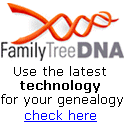
Kashubian Genetics: Abstracts and Summaries
Kashubians are a West Slavic ethnic group living in Pomerelia in north-central Poland, adjacent to Pomerania. Their region is also known as Kashubia (Kaszuby). Katarzyna Warmińska wrote in her chapter in Multiple Identities: Migrants, Ethnicity, and Membership that "The Kashubians are descendants of the Western-Slavonic Baltic tribes." Those tribes had lived in the area before Poles moved there.
A distinct Kashubian language was forming by the 14th century. Mainly built from West Slavic word stock, Kashubian also includes several percentage points worth of Low German words as well as some words adopted from Baltic languages, Russian, and standard Polish.
A particular Kashubian was stated to belong to the mtDNA haplogroup T2b by 23andMe but since 23andMe (unlike Family Tree DNA's full coding region test) fails to indicate precise clade assignments for many haplogroups her data was processed through a more stringent analysis tool that determined she's specifically in the branch called T2b7a1.
Major studies of Kashubians
Alena Kushniarevich, Olga Utevska, Marina Chuhryaeva, Anastasia Agdzhoyan, Khadizhat Dibirova, Ingrida Uktveryte, Märt
Möls, Lejla Mulahasanovic, Andrey Pshenichnov, Svetlana Frolova, Andrey Shanko, Ene Metspalu, Maere Reidla, Kristiina Tambets, Erika Tamm, Sergey Koshel, Valery Zaporozhchenko, Lubov Atramentova, Vaidutis Kučinskas, Oleg Davydenko, Olga Goncharova, Irina Evseeva, Michail Churnosov, Elvira Pocheshchova, Bayazit Yunusbayev, Elza Khusnutdinova, Damir Marjanović, Pavao Rudan, Siiri Rootsi, Nick Yankovsky, Phillip Endicott, Alexei Kassian, Anna Dybo, The Genographic Consortium, Chris Tyler-Smith, Elena Balanovska, Mait Metspalu, Toomas Kivisild, Richard Villems, and Oleg Balanovsky.
"Genetic Heritage of the Balto-Slavic Speaking Populations: A Synthesis of Autosomal, Mitochondrial and Y-Chromosomal Data." PLoS ONE 10:9 (September 2, 2015): e0135820.
Per Table K, "Frequencies of the NRY haplogroups in Balto-Slavic populations", the distribution of Y-DNA haplogroups among the Kashubian participants included:
3.4% in E1b1b,
13.2% in I1,
4.4% in I2,
61.8% in R1a (by far their most frequent haplogroup),
9.3% in R1b,
7.9% in other haplogroup(s).
Marcin Woźniak, Boris Abramovich Malyarchuk, Miroslava V. Derenko, T. Vanecek, J. Lazur, P. Gomolcak, and Tomasz Grzybowski.
"Similarities and distinctions in Y chromosome gene pool of Western Slavs."
American Journal of Physical Anthropology 142:4 (August 2010): pages 540-548.
This study tested the Y-DNA of 142 males living in northern Poland including ethnic Kashubians and ethnic Poles. The distribution of Y-DNA haplogroups among the Kashubian participants included:
3.1% in E1b1b,
12.5% in I1,
3.1% in I2,
3.1% in Q1a (ultimately of Asian/Siberian origin),
68.8% in R1a (by far their most frequent haplogroup),
7.8% in R1b.
Overall, the proportions of haplogroups among Kashubians and Poles were found to be similar.
Marta Mielnik-Sikorska, Patrycja Daca, Boris Malyarchuk, Miroslava Derenko, Katarzyna Skonieczna, Maria Perkova, Tadeusz Dobosz, and Tomasz Grzybowski.
"The History of Slavs Inferred from Complete Mitochondrial Genome Sequences."
PLoS ONE 8:1 (January 14, 2013): e54360.
Includes mitochondrial DNA (mtDNA) samples from 404 native inhabitants of Poland (including Kashubians from Kashubia as well as Poles from Podhale in far-southern Poland), 157 Ukrainians, and 85 Czechs. They note that "a significant part of this population [from Kashubia] consists of descendants of the Pomeranian branch of Slavs called Kashubians". Table 1 presents "Frequencies of the major mtDNA haplogroups" and for inhabitants of Kashubia they give the following counts grouped by haplogroup families:
1 in C,
1 in G,
18 in H* (8.9%),
24 in H1 (11.8%),
5 in H2a (2.5%),
1 in H3,
6 in H4 (3%),
4 in H5,
1 in H6,
3 in H7,
1 in H8,
8 in H10 (3.9%),
6 in H11 (3%),
1 in H13a,
3 in HV*,
1 in HV0*,
4 in I,
1 in J*,
25 in J1 (their most common haplogroup with a frequency of 12.3%),
2 in J2,
6 in K (3%),
1 in L,
12 in T* (5.9%),
4 in T1,
11 in T2 (5.4%),
2 in U1a'c,
2 in U2e,
2 in U3,
8 in U4a (3.9%),
11 in U5a (5.4%),
11 in U5b (5.4%),
1 in U7,
1 in U8,
6 in V (3%),
5 in W (2.5%),
4 in X.
 Family
Tree DNA Genealogy by Genetics, Ltd. - This site is an affiliate
23andMe: Genetic Testing for Ancestry
Poland
Genealogy and Family History Resources
Family
Tree DNA Genealogy by Genetics, Ltd. - This site is an affiliate
23andMe: Genetic Testing for Ancestry
Poland
Genealogy and Family History Resources
The Kashubian Polish Community of Southeastern Minnesota by the Polish Cultural Institute
A Historical Phonology of the Kashubian Dialects of Polish by Zuzanna Topolinska
The Kashubs: Past and Present edited by Cezary Obracht-Prondzynski and Tomasz Wicherkiewicz
Kashubian Heart Ceramic Tea Bag Saucer by Polish Folk Art
Kashubian Design Pillow Cover by Awowee
Genetics of
Polish People
Genetics of
Jewish (Israelite) People




